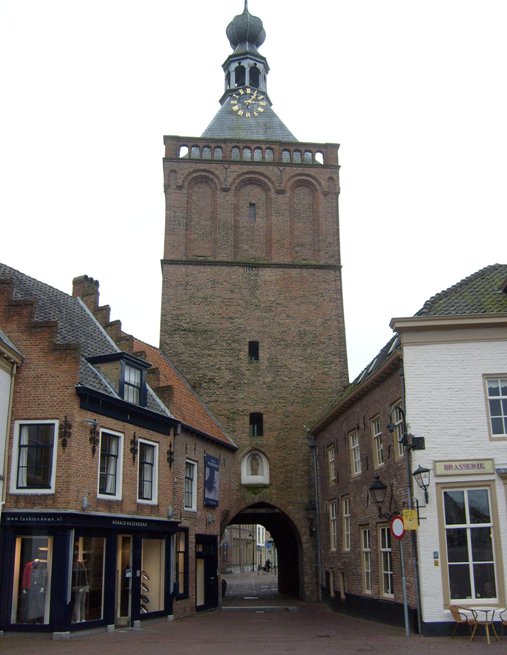ArtistsAndriessen, Mari - VM - Rob den Boer
Mari Andriessen: Saint Barbara

In Search of a New Life
by Rob den Boer
Saint Barbara looks at us from above the market square of Culemborg, a small city in the middle of the Netherlands, as if she is peacefully resting in a sarcophagus. Her effigy is immured in the tower façade of the Binnenpoort gate, just above an underpass. The Dutch sculptor Mari Andriessen chiselled in her left hand a tower, one of her main attributes.
According to legend, Barbara of Nicodemia (a city in the Roman Empire in a region now in Turkey) was exceedingly beautiful. To keep her away from the eager eyes of numerous young men, her father had locked her up in a tower. In turn she had in her father’s absence commissioned builders to include not two but three windows in the wall of the tower. These represented the Holy Trinity to her, Father, Son and Holy Spirit, and kept her eyes focused on a new life in Christ.
At a young age Barbara had converted to Christianity, which in her time, the third century A.D., was rapidly acquiring many followers throughout the Roman Empire. Her pagan father had her tortured because of her faith, but each time her wounds healed in a miraculous way. After her father decapitated her, he was killed by lightning. That is why Barbara holds in her right hand a palm branch, the symbol of martyred saints.
Due to her tragic death Barbara was soon considered a saint. She became the patron of people engaged in dangerous work such as artillerists, firemen and later also miners. Workmen who come into contact with death, for example grave diggers, could also count on her protection as well as builders, because of the tower where she was imprisoned. In 1421 Hubrecht III, lord of Culemborg, founded in the Grote Kerk (LargeChurch) in Culemborg a chapter dedicated to Barbara. Each day a group of men prayed there for Hubrecht, probably to shield him from a sudden death. Since that time the church has been called Saint Barbara. She is also the patron saint of the city.
In 1566 the first Calvinistic church service of the Netherlands was conducted in the washing house of the ducal Castle of Culemborg. In September of that year iconoclastic fury raged through the land. The Saint Barbara Church in Culemborg also suffered damage. Traces of this are still visible. Twelve years later the Roman-Catholic parish lost the church to the Protestants, who still gather there. Only in the 19th century were Catholics allowed to profess their faith in public again, which also led to a revival of the veneration of Barbara. Close to the old church a totally new Catholic Saint Barbara Church was consecrated in 1886.

Seventy years ago Saint Barbara was immortalized in the facade of the Binnenpoort gate. It is a tower of several storeys with a gate that gives access to the Markt, the central town square. During a restauration in 1940-1943 an alcove from the 16th century was discovered in the tower façade. Before WW II Mari Andriessen, a well-known sculptor in the Netherlands, specialized in plaques with biblical themes. His sculpture of Saint Barbara was placed in the alcove. Its clear formal language and sand coloured stone harmonize beautifully with the architecture.
On the tower we see the number three recur: near the top of the tower through three arched blind windows and below them in the two small openings and alcove which have been incorporated into the façade.
At the other side of the gate an Old-Catholic church was built in 1836, which was also dedicated to Saint Barbara. The three windows Barbara had installed in her tower are mirrored in Culemborg’s three churches which bear her name, Catholic, Old-Catholic and Protestant. Together the three towers point to the Holy Trinity. For me they are a symbol for churches that seek each other out again and Christians who in all their diversity once more become one in Christ.
*******
Mari Andriessen: Saint Barbara, 1943, stone carving, Culemborg, NL.
Mari Andriessen (1897-1979) was born into a Catholic family in Haarlem, the Netherlands. His brother Hendrik was a well-known composer. Upon the completion of his training at the National Academy of Art in 1923, Mari Andriessen received many commissions from churches and Christian building societies due to his Catholic heritage. He made strongly stylized plaques and sculptures on biblical themes inspired by medieval examples. During WW II Andriessen refused to become a member of the Nederlandsche Kultuurkamer which sympathized with the Germans, which meant that he no longer received any commissions and was not allowed to have any exhibitions. He joined the resistance and hid Jews in his house. After the war many towns commissioned war or resistance monuments from him. Well-known are hisDokwerker in Amsterdam (1952) and Anne Frank near the Westerkerk in Amsterdam (1975). Later he was given important commissions like the statues of Albert Plesman in The Hague (1958) and of Queen Wilhelmina in Utrecht and Amsterdam (both 1967). His sculptures are characterized by their vigorous and clear compositions and simplification of detail. To view some of his works, seehttp://en.wikipedia.org/wiki/Mari_Andriessen.
Rob den Boer is a Dutch visual artist and a member of the ProtestantChurch in the Netherlands (PKN). He lives in Culemborg. See www.robdenboer.nl.
ArtWay Visual Meditation 19 January, 2014


